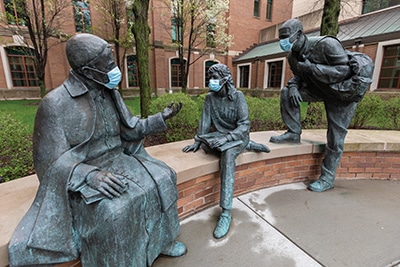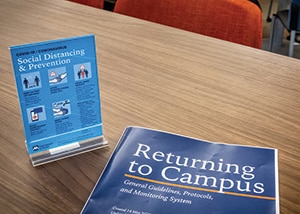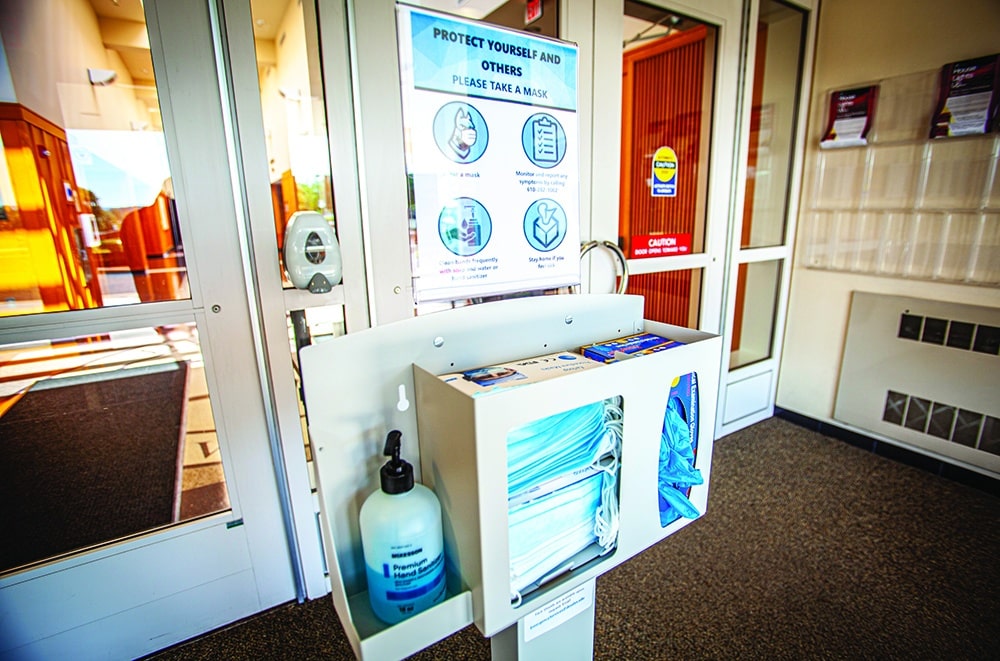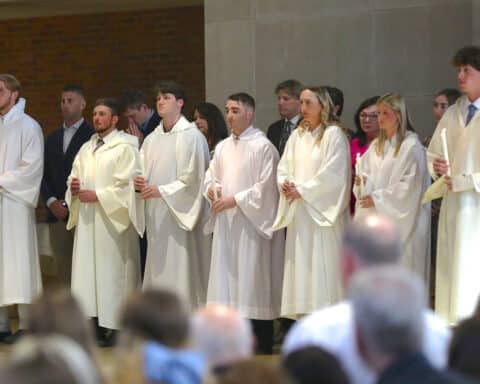Students returning to Catholic college campuses for the fall semester will find many things changed to mitigate the risk of students, faculty and staff contracting COVID-19, but they will also find some things that have remained constant.
“We try to view everything we do here through a Catholic lens,” said Richard Ludwick, president of the University of St. Thomas in Houston. “‘We look at God’s love and the dignity and the human person, and how do we operate understanding that? And doing so with the understanding that our mission is to serve the people or God in a way that respects that. When it comes to our mission and values, it’s business as usual.”
Keeping students and staff safe means some campuses, like the University of Notre Dame in Indiana, will begin classes earlier than usual and skip regularly scheduled fall breaks so as to end the first semester before Thanksgiving. Others, like Loyola University Chicago, will allow a certain percentage of students to live on campus but will be offering most courses online.
Read other stories in our special college section here.
Universities are making double rooms in residence halls singles, or making quads and triples doubles. They are issuing masks and requiring that they be worn, and they are installing plexiglass barriers to protect students and staff where they can. They are painting footprints and pawprints and arrows on footpaths to show people where to walk, stand and wait. They are restricting visitors to campuses. They are asking students and staff to monitor and report symptoms, and in some cases, to be tested for the virus before they return to campus and while they are there.
Following local guidelines
Jennifer Boyd-Pugh, vice president of Barry University in Miami Shores, Florida, said universities across the country are looking for multiple ways to mitigate risk. Cases also surged in Florida beginning in late June.
“We’re trying to ensure that we have a significant amount of layers of protection in place,” Boyd-Pugh said. “No one thing alone is going to prevent the spread of COVID-19.”
In Barry’s case, that means training everyone on how to stay safe and observe restrictions. The university will limit classrooms to, at most, 50% capacity. If the situation in South Florida remains the same, classrooms could be limited to 10 people at a time, Boyd-Pugh said, with enrolled students taking turns attending in person and online.
The watchword, said Ludwick of the University of St. Thomas, is flexibility.
Houston, and Texas as a whole, have seen surging numbers of cases of COVID-19 and a growing positivity rate since mid-June, which have already caused the university to make adjustments to its original plans.
“We see this roller coaster of data,” Ludwick said. “We’re not going to follow the plan that we established because it doesn’t fit the current situation. What we have is the ability to pivot quickly. That will help us be ready for any contingency that comes. We don’t have any set-in-stone plan because that’s pretty much worthless.”
Ludwick said plans as of late July called for the university to stop using its residence halls as housing for staff at the nearby Texas Medical Center in early August so they could deep clean them and have them ready for students, with the caveat that fewer students will live there. Airflow patterns and foot traffic patterns are being analyzed. Masks will be required and social distancing will be enforced.
Providing quality education
At the same time, the university has worked to build its capacity to deliver quality education online since the pandemic forced it to close its doors in March. That means adding technological infrastructure, from increasing campus bandwidth to providing all students with Surface Go computers, but also adopting best practices in terms of online teaching methods.

“Faculty are rebuilding their classes so they can deliver them online or they can go online very quickly,” Ludwick said, adding that the school wants to be able to recreate the feeling of a classroom community as much as possible.
Even before the pandemic, the University of St. Thomas was hiring educational technologists and educational designers to help it play to its strengths, Ludwick said.
“We want to be able to harness that personal connection between professor and student, understanding how the liberal arts form the core of our curriculum,” he said, noting that the university has grown in recent years and expects to continue to do so. “It’s not just delivering content over distance, it’s online learning. There’s a difference.”
The university’s student population is diverse socioeconomically and majority Latino, and most come from the Houston metro area, Ludwick said. When one in four reported last spring that they had some internet connectivity issues, the university began working with area internet providers to connect students to free hotspots.
The end result will be, at the very least, a hybrid program that allows flexibility for students and faculty and staff. What it will look like on opening day, Aug. 24, was to be announced Aug. 10.
“What we wanted to do was give our faculty and students choices,” Ludwick said. “We asked, ‘Do you want to come back and teach on campus?’ A lot of our faculty said, ‘You know what? I’m good teaching from home.’ We could have some classes all online, some hybrid, some all face-to-face.”
Silver linings
Boyd-Pugh said people have a range of opinions and feelings about returning to school
“It’s running the whole gamut,” she said. “There’s a lot of students who are just looking forward to coming back to campus and being amongst friends. There are faculty staff and students who are fearful due to the spread of the virus.”
Barry is drawing on the lessons learned after switching to remote instruction in the spring, she said.
“We’ve learned a lot over the past months,” Boyd-Pugh said. “The model we’re building is based on flexibility. We’ll be able to pivot and go remote, even for a short period of time. So if we had a surge on campus, we could do remote instruction for two weeks or three weeks.”
Most Barry students – 85% – are commuters, she said.
It’s important to remember that Barry, like other universities, might have closed its campus but never stopped operating in the spring semester.
“The university has never been closed at any period of time,” she said. “We have provided all services to our students in a remote fashion.”
That includes academics, but also advising, student groups and even health services.

Some of the changes, she said, will be permanent.
“It is going to be different,” Boyd-Pugh said. “I think this is going to be our new norm. It’s about building real engagement opportunities both in person and virtually.”
There have been other silver linings, she said.
“I think we’ve seen a lot of innovation come out of this, just from a technology standpoint,” Boyd-Pugh said. “We’ve always heard about telecommuting and telework and things of this nature, but it was never done to a scale that we’ve seen over the last three months.”
Boyd-Pugh said the most important thing to remember as students and faculty return is that each person has to take responsibility for protecting the safety and health of the entire community.
“At the end of the day, any return to in-person learning is going to boil down to personal responsibility,” she said. “It’s going to be adherence to the guidelines and the layers of protection. It’s on every single person to take personal responsibility.”
Michelle Martin writes from Illinois.





